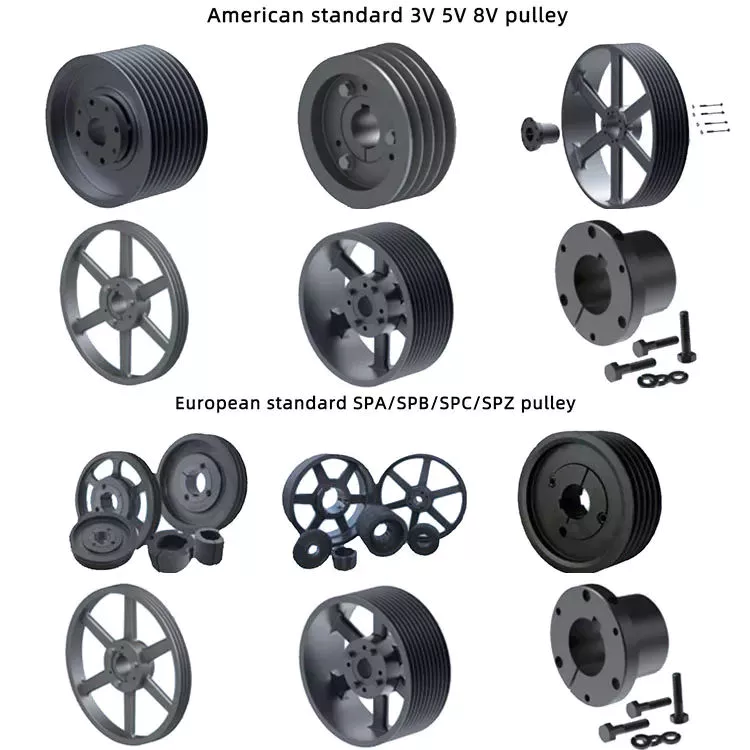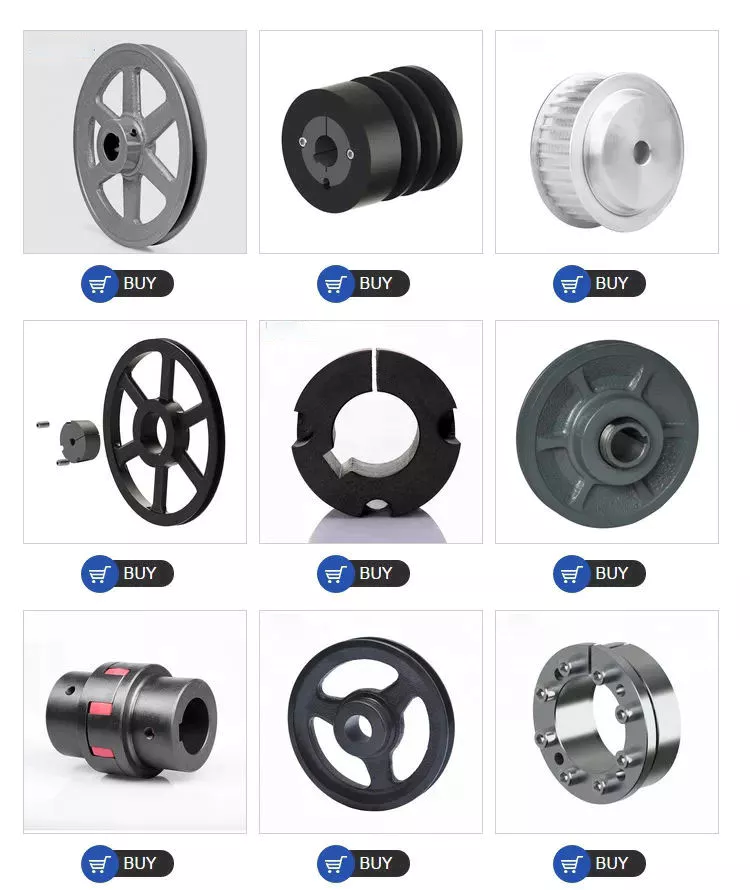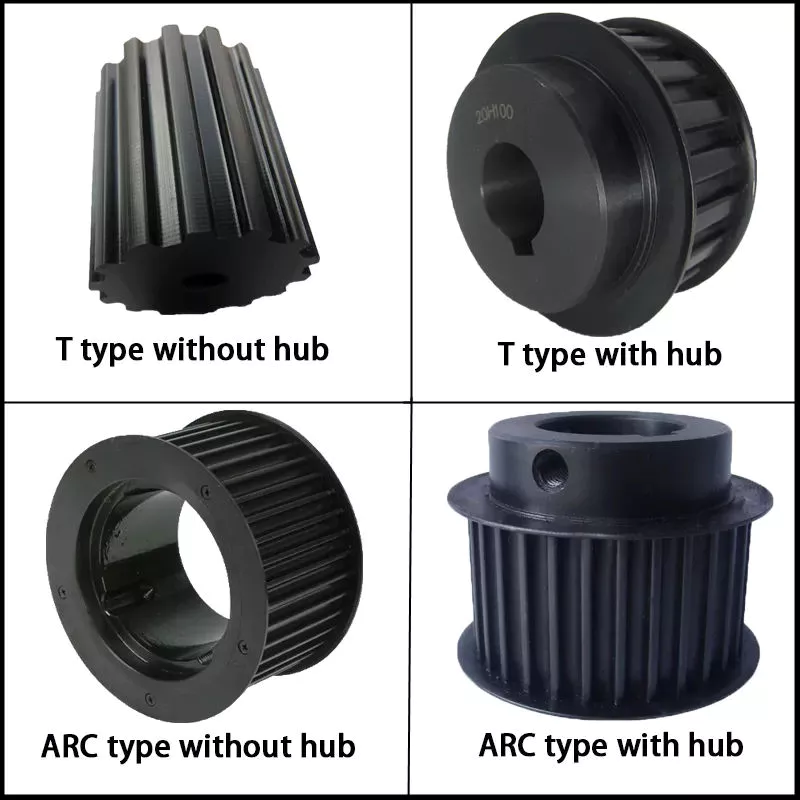Productomschrijving
Productomschrijving
A timing pulley is a wheel component used for transmission, which is often used in combination with a timing belt or a synchronous chain to achieve precision synchronous transmission. The timing pulley usually consists of 2 parts: the wheel flange and the hub. The wheel flange usually has a toothed structure that can be combined with a timing belt or chain to achieve a precise synchronous transmission effect. Synchronous wheels can be divided into 2 categories: grinding gear synchronous wheels and forged tooth synchronous wheels.
Productparameters
| product | Metal Iron Timing Belt Pulley/ Synchronous Belt Pulley for Packaging machine |
| material | stainless steel , iron , aluminum ,bronze ,carbon steel ,brass etc . |
| maat | ISO standard ,customer requirements |
| BORE | Finished bore, Pilot Bore, Special request |
| surface treatment | Carburizing and Quenching,Tempering ,Tooth suface high quenching Hardening,Tempering |
| Verwerkingsmethode | Molding, Shaving, Hobbing, Drilling, Tapping, Reaming, Manual Chamfering, Grinding etc |
| Heat Treatment | Quenching & Tempering, Carburizing & Quenching, High-frequency Hardening, Carbonitriding…… |
| Pakket | Wooden Case/Container and pallet, or made-to-order |
| Certificate | ISO9001 ,SGS |
| Machining Process | Gear Hobbing, Gear Milling, Gear Shaping, Gear Broaching, Gear Shaving, Gear Grinding and Gear Lapping |
| Applications | Toy, Automotive, instrument, electrical equipment, household appliances, furniture, mechanical equipment,daily living equipment, electronic sports equipment, , sanitation machinery, market/ hotel equipment supplies, etc. |
| Testing Equipment | Rockwell hardness tester 500RA, Double mesh instrument HD-200B & 3102,Gear measurement center instrument CNC3906T and other High precision detection equipments |
workshop & equipment
Production process
Certificeringen
Onze voordelen
1 . Prioritized Quality
2 .Integrity-based Management
3 .Service Orientation
4 .150+ advanced equipment
5 .10000+ square meter factory area
6 .200+ outstanding employees
7 .90% employees have more than 10 year- working experience in our factory
8 .36 technical staff
9 .certificate ISO 9001 , SGS
10 . Customization support
11 .Excellent after-sales service
shipping
sample orders delivery time:
10-15 working days as usual
15-20 working days in busy season
large order leading time :
20-30 working days as usual
30-40 working days in busy season
Veelgestelde vragen
1. why should you buy products from us not from other suppliers?
We are a 32 year-experience manufacturer on making the gear, specializing in manufacturing varieties of gears, such as helical gear ,bevel gear ,spur gear and grinding gear, gear shaft, timing pulley, rack, , timing pulley and other transmission parts . There are 150+ advanced equipment ,200+ excellent employees ,and 36 technical staff . what's more ,we have got ISO9001 and SGS certificate .
2: What are the common types of tooth profiles for synchronous belt pulleys?
A: The most common tooth profiles for synchronous belt pulleys are the trapezoidal (or T-type) and curvilinear (or HTD-type) profiles. The tooth profile determines the pitch diameter, which affects the overall ratio of the gear drive.
3 .How long is the delivery?
A: Small orders usually takes 10-15 working days,big order usually 20-35 days, depending on orders quantity and whether are standard size.
/* March 10, 2571 17:59:20 */!function(){function s(e,r){var a,o={};try{e&&e.split(“,”).forEach(function(e,t){e&&(a=e.match(/(.*?):(.*)$/))&&1
| Certificering: | ISO |
|---|---|
| Katrolmaten: | Type D |
| Productieproces: | Forging |
| Materiaal: | Roestvrij staal |
| Oppervlaktebehandeling: | Galvaniseren |
| Sollicitatie: | Chemische industrie, graantransport, mijnbouwtransport, elektriciteitscentrale |
| Voorbeelden: |
US$ 5/Piece
1 stuk (min. bestelling) | |
|---|
| Aanpassing: |
Beschikbaar
| Aangepast verzoek |
|---|

Can pulleys be used in both simple and complex mechanical systems?
Yes, pulleys can be used in both simple and complex mechanical systems. Pulleys are versatile mechanical devices that can be incorporated into a wide range of systems to transmit power, change direction, or provide mechanical advantage.
In simple mechanical systems, pulleys are often used to create a mechanical advantage by reducing the effort force required to lift or move a load. For example, a simple pulley system with a single fixed pulley can distribute the load's weight over multiple strands of rope or cable, reducing the force needed to lift the load. Simple pulley systems are commonly used in applications such as flagpoles, well buckets, or manual hoists.
In more complex mechanical systems, pulleys can be part of intricate arrangements to achieve specific functions. They can be combined with multiple pulleys, belts or ropes, and other mechanical components to create complex systems for power transmission, tensioning, or precise control. Examples of complex systems that utilize pulleys include conveyor belt systems, industrial machinery, cranes, and elevators.
Pulleys offer several advantages in both simple and complex mechanical systems:
1. Mechanical Advantage: Pulleys can provide a mechanical advantage by distributing the load's weight over multiple strands of rope or belt, reducing the effort force required to lift or move the load.
2. Direction Change: Pulleys can change the direction of the force applied, allowing for redirection of motion or routing of belts or ropes around obstacles.
3. Speed Adjustment: By adjusting the size of pulleys and the number of pulley systems, the speed of the output motion can be modified relative to the input motion.
4. Power Transmission: Pulleys are effective in transmitting power between shafts or components, allowing for the transfer of rotational motion and torque.
5. Versatility: Pulleys can be used with different types of belts or ropes, such as flat belts, V-belts, timing belts, or wire ropes, providing flexibility in design and application.
Whether in simple or complex mechanical systems, the selection, arrangement, and sizing of pulleys should be carefully considered to ensure proper functionality, efficiency, and safety. Manufacturers' guidelines, engineering principles, and best practices should be followed when incorporating pulleys into mechanical systems.

Waarom is het belangrijk om de poelie goed uit te lijnen en op spanning te brengen?
Juiste uitlijning en spanning van de katrol zijn cruciale factoren om de efficiënte en betrouwbare werking van katrolsystemen te garanderen. Ze spelen een belangrijke rol bij het maximaliseren van de krachtoverbrenging, het minimaliseren van slijtage en het behouden van de algehele prestaties en levensduur van het systeem. Hier is het belang van juiste uitlijning en spanning van de katrol:
1. Efficiëntie van krachtoverbrenging:
Proper pulley alignment and tensioning ensure optimal power transmission efficiency. When pulleys are misaligned or belts/chains are improperly tensioned, energy is wasted due to increased friction and slippage. This results in decreased power transfer and reduced system efficiency. By aligning the pulleys parallel to each other and applying the correct tension to the belts or chains, the system can achieve maximum power transmission, minimizing energy losses.
2. Levensduur van de riem/ketting:
Correcte uitlijning en spanning van de poelie dragen bij aan de levensduur van riemen en kettingen. Verkeerde uitlijning en onvoldoende spanning kunnen ongelijkmatige slijtage, overmatige rek en voortijdig falen van de riemen of kettingen veroorzaken. Correcte uitlijning en spanning verdelen de belasting gelijkmatig over de riemen of kettingen, waardoor de spanning wordt verminderd en hun levensduur wordt verlengd. Dit helpt om ongeplande uitvaltijd, onderhoudskosten en de noodzaak voor frequente vervanging van riemen/kettingen te voorkomen.
3. Minder lawaai en trillingen:
Onjuiste uitlijning en spanning van de katrol kan leiden tot meer lawaai en trillingen in het systeem. Verkeerd uitgelijnde katrollen of losse riemen/kettingen kunnen overmatige trillingen veroorzaken, wat resulteert in lawaai, schade aan apparatuur en ongemak voor operators of personeel in de buurt. Juiste uitlijning en spanning helpen trillingen te minimaliseren, wat zorgt voor een stillere werking en een comfortabelere werkomgeving.
4. Systeembetrouwbaarheid en veiligheid:
Juiste uitlijning en spanning dragen bij aan de algehele betrouwbaarheid en veiligheid van katrolsystemen. Verkeerd uitgelijnde katrollen of losse riemen/kettingen kunnen leiden tot onverwachte storingen, defecten of ongelukken. Te veel spanning kan ook leiden tot overmatige spanning op componenten en het risico op systeemstoringen vergroten. Door de juiste uitlijning en spanning te handhaven, werkt het systeem binnen de ontwerpparameters, waardoor de kans op onverwachte storingen wordt verkleind en de veiligheid van operators en apparatuur wordt gewaarborgd.
5. Verbeterde prestaties:
Correcte uitlijning en spanning van de poelie verbeteren de algehele prestaties van het systeem. Correct gespannen riemen of kettingen bieden betere grip en tractie, wat zorgt voor een soepelere en nauwkeurigere beweging van de aangedreven componenten. Dit resulteert in een verbeterde snelheidsregeling, minder slippen en een grotere nauwkeurigheid in toepassingen zoals transportsystemen, machinegereedschappen en automotoren.
6. Onderhoud en kostenbesparing:
Correcte uitlijning en spanning van de poelie kan leiden tot aanzienlijke onderhouds- en kostenbesparingen. Goed uitgelijnde poelies en correct gespannen riemen of kettingen ervaren minder slijtage en vereisen minder aanpassingen. Dit vermindert de frequentie van onderhoudstaken, zoals het vervangen van riemen/kettingen, opnieuw uitlijnen en opnieuw spannen. Bovendien helpen correcte uitlijning en spanning, door de efficiëntie van de krachtoverbrenging te maximaliseren en slijtage te minimaliseren, het energieverbruik te verminderen en de bedrijfskosten te verlagen.
Concluderend zijn de juiste uitlijning en spanning van de katrol cruciaal voor het bereiken van optimale efficiëntie van de krachtoverbrenging, het verlengen van de levensduur van riemen of kettingen, het verminderen van geluid en trillingen, het garanderen van de betrouwbaarheid en veiligheid van het systeem, het verbeteren van de prestaties en het realiseren van onderhouds- en kostenbesparingen. Het is essentieel om de richtlijnen van de fabrikant te volgen en regelmatig inspecties en aanpassingen uit te voeren om de juiste uitlijning en spanning in katrolsystemen te behouden.

What materials are typically used to manufacture pulleys?
Pulleys are manufactured using a variety of materials, depending on the specific application and requirements. Here are some of the materials that are typically used to manufacture pulleys:
1. Metal Alloys: Metal alloys such as steel and cast iron are commonly used to manufacture pulleys. Steel pulleys offer excellent strength, durability, and resistance to wear and corrosion. Cast iron pulleys are known for their high strength and resistance to impact and shock loads. Metal alloys are preferred in heavy-duty applications where strength and durability are critical.
2. Aluminum: Aluminum is widely used in pulley manufacturing due to its lightweight nature and corrosion resistance. Aluminum pulleys are commonly used in applications that require reduced weight, such as automotive engines, aircraft components, and light-duty machinery. They offer good strength-to-weight ratio and are suitable for applications where weight reduction is a priority.
3. Plastic: Various types of plastics, including nylon, polyurethane, and high-density polyethylene (HDPE), are used to manufacture pulleys. Plastic pulleys are lightweight, corrosion-resistant, and offer good resistance to wear and abrasion. They are commonly used in applications where noise reduction, chemical resistance, or non-conductive properties are required. Plastic pulleys are frequently used in conveyor systems, packaging machinery, and small-scale equipment.
4. Composite Materials: Composite materials, such as fiberglass-reinforced plastic (FRP) and carbon fiber-reinforced polymer (CFRP), are utilized in the manufacturing of pulleys. These materials offer high strength-to-weight ratios, excellent resistance to corrosion, and good fatigue resistance. Composite pulleys are commonly used in industries such as aerospace, marine, and sports equipment, where lightweight components with exceptional strength are required.
5. Ceramics: In certain specialized applications, pulleys made of ceramics like aluminum oxide (alumina) or silicon nitride are used. Ceramic pulleys offer exceptional hardness, high temperature resistance, and excellent wear resistance. They are primarily used in industries such as semiconductor manufacturing, where extreme precision, chemical resistance, and resistance to high temperatures are crucial.
It's important to note that the choice of material for pulley manufacturing depends on factors such as load capacity, operating conditions, environmental factors, and cost considerations. Manufacturers select materials that provide the necessary properties to meet the specific requirements of the application while considering factors such as strength, durability, weight, and cost.


redacteur door CX
2024-02-04
